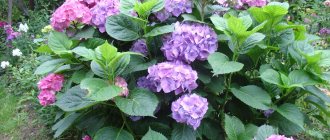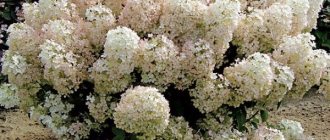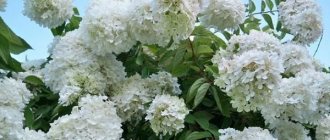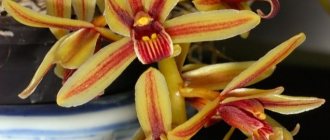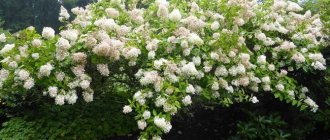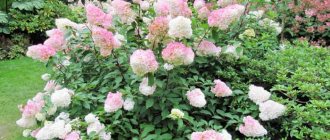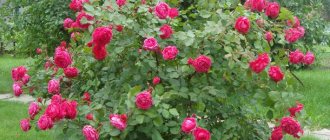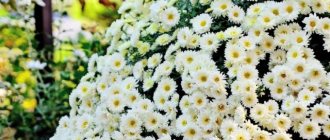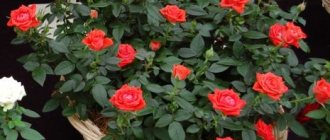Use in landscape design
Hydrangeas have been used in landscape design for a very long time.
A highly decorative flower that looks beautiful with almost all plants. In parks it is planted next to trees and large bushes. Tree hydrangea Grandiflora favorably emphasizes flower beds and flower beds with its elegant appearance. The large-leaved species (Hydrangea Paniculata) is often planted together with conifers: thuja, fir or juniper. To decorate the garden, you can place the hydrangea Grandiflora Paniculata next to fruit and berry bushes.
Grandiflora is a beautiful variety that is resistant to frost and disease.
Hydrangea Grandiflora is a popular ornamental plant that is widely used in landscape design. The unpretentious flower is easy to propagate and plant in open ground, as it quickly adapts to new conditions and rarely gets sick.
Hydrangea largeleaf
of large-leaved hydrangea with large spherical inflorescences, which is more demanding of care than tree-like and paniculate, is distinguished by its incredible beauty Bushes should be planted in partial shade, carefully protected from frost, or seedlings should be planted in large containers to make it easier to move them indoors by winter.
The most beautiful varieties of large-leaved hydrangea:
- Niko Blue with blue inflorescences up to 30 cm in diameter can be grown as a houseplant;
- Alpenglüchen with red flowers fits perfectly into a bright garden;
- Red Baron with beautiful leaves also has large inflorescences of rich red color;
- Schniebol with luxurious white inflorescences is a new variety of large-leaved hydrangea;
- Kumiko is a variety with pink inflorescences.
Aftercare
In the hot season, gardeners in the Moscow region need to more carefully care for hydrangeas: regularly spray the green part with water, and water the soil around the root system evenly. During the season, fertilizing is carried out with organic fertilizers, as well as solutions of nitrophos and superphosphate. Periodically you need to trim dry and diseased branches. Thanks to this, the plant acquires a neat, lush crown.
Hydrangea propagation is carried out in 3 ways: cuttings, seeds and layering. If cultivation is carried out by seeds, then for this you will need a large pot of soil, into which the seeds are planted in the fall. If the soil is regularly moistened, shoots will sprout after some time. In spring, young shoots are used as cuttings and planted under a cut plastic bottle. Within a month the plant is watered and it takes root.
Low growing shrubs
For a small garden or personal plot, small varieties of paniculata hydrangea are suitable. Their height varies from 50 to 100 cm. The best varieties of hydrangea for the Moscow region:
- Bobo is a low shrub that will harmoniously fit into the design of a small area. Among all paniculate hydrangeas it is the first to bloom. The color of the flowers is white and does not change throughout the season.
- Dharuma is a dwarf shrub species. The inflorescences have a delicate milky-cream color. A distinctive feature is the bright red shoots. Clusters with rare large flowers. Towards the end of the season the blooms turn pink. This variety does not tolerate rainy weather well. If the summer is cold, the flowers take on a dirty pink hue. The plant does not require fertilizers. Grows best in acidic or neutral soils.
- Wim's Red is a compact variety. In 10 years, the shrub will not grow more than 70 cm. It has a characteristic feature - its shoots retain a rich burgundy color throughout the entire season. The inflorescences are flat and have the shape of convex disks. The brushes are dense. Along the edges there are large sterile flowers with dense petals. Flower color changes radically throughout the season. Blooming buds are white. Gradually they turn pink. Towards the end of the warm season they turn dark crimson.
- Little Lime is mistakenly considered by some to be a smaller copy of Limelight, but they are different varieties. The shrub does not grow more than 50−60 cm in height. The crown forms a ball shape on its own, without additional cutting or artificial shaping. The change in palette is interesting: at first the flowers are painted in soft cream tones. Gradually they turn into salmon and then orange. By the end of flowering, a dark contrasting border appears on each petal. This border is more characteristic of large-leaved hydrangea species.
Landing
Hydrangeas are an excellent purchase for gardeners. In order for this plant to please with lush flowering, you must adhere to several rules.
Hydrangea takes root well in loam, so it is recommended to plant it in such soil; Constant abundant soil moisture is necessary during dry periods. The plant loves good lighting, but does not tolerate direct bright sunlight (it is important to take this factor into account when choosing a site for planting). Hydrangea does not like drafts; it should be protected from this phenomenon. Every spring it is necessary to prune the plant: cut off old and broken branches. In autumn you need to remove faded inflorescences.
Chereshkova
This is an unusual hydrangea - not a bush, but a perennial vine, characterized by increased decorativeness. In the wild, its length can exceed 25 meters, but at home it rarely grows to 3 meters.
It is attached to the surface using aerial roots. It is distinguished by pale rounded leaves. The flowers are greenish-white or pink, and may be light lavender. Collected in an inflorescence with a diameter of 15-27 cm.
Flowering occurs in the second half of summer and ends with the arrival of autumn frosts. The variety tolerates midland winters well, but in more northern latitudes it can freeze.
Despite its unpretentiousness, it is quite rare in areas. The reason is its unusual form. There are two methods for propagation: cuttings and seeds.
Climbing petiolate hydrangea will help tastefully decorate the appearance of country houses and gazebos
How to choose?
You can buy hydrangea seedlings in specialized stores. First you need to decide on the choice of variety, since the final result depends on this.
Frost-resistant plant varieties grow well in this climate zone.
The paniculate species adapts well to the climatic conditions of the Moscow region. It is recommended to purchase the plant with a closed root system and plant it in the garden in late spring. Therefore, when purchasing, you need to carefully examine the roots. Healthy roots will be strong, without signs of mold, and the soil will be moderately moist. A good seedling will have several strong shoots.
If the choice fell on the climbing type of hydrangea, then it is important to know that it does not like transplanting. Therefore, before purchasing, you need to decide on the choice of permanent “place of residence” for the plant.
A healthy seedling will have a well-developed root system. The roots of climbing hydrangea grow more horizontally than in depth. Accordingly, the holes for planting should be shallow, but wide enough.
The broadleaf type of hydrangea is a heat-loving species, so it will require additional care. Young seedlings should not be grown in open ground right away, since the plant is too tender and will not survive the winter cold. It is recommended to purchase the flower in pots and keep it indoors as a houseplant for several years. After 2–3 years, the hydrangea can be taken to an area protected from bright sun and drafts and left for the summer to adapt.
New items in the world of hydrangeas: hybrid varieties
Breeders are putting a lot of effort into pleasing fans of unique plants with new products; for example, the multi-colored hydrangea has recently appeared, combining a unique unusual color with ease of care. Samara Lydia is a plant with bright ruby inflorescences, ideal for landscape composition. The height of the compact bush is up to 1 meter, width - approximately 1.2 meters. The leaves are rich green.
The bright red flowers of the Weems Red shrub will become a real decoration for any area. The variety is unpretentious in care and survives even severe frosts well, and is resistant to diseases and major pests. The average height of the bush is 2 meters.
Note! Hybrid varieties, including early flowering ones, are moisture-loving, but you should not flood the plantings, otherwise gray rot may develop.
Little Fraze is a compact paniculate hydrangea with white and pink flowers. Suitable for growing in a pot, since the height rarely exceeds 80 cm. Caring for this low-growing hydrangea is quite simple.
Skyfall is a hybrid paniculate variety with yellow-white petals and cone-shaped inflorescences. Planting in open ground in a well-lit place by the sun is allowed.
Snow-white hydrangea Skyfall goes well with many flowering crops
Hydrangea paniculata: the best varieties
Hydrangea paniculata variety Vanilla Fraize (Vanilla Fraize, Rennie)
The hydrangea variety Vanilla Fraze is a spreading bush up to 2 meters high. The flowers are initially pure white, but over time they take on an increasingly intense pink color. A late-blooming variety of hydrangeas, frost-resistant. Sunday Fraze is a smaller copy of the Vanilla Fraze variety of hydrangea. This hydrangea variety prefers sunny, wind-protected locations and moist soils.
Hydrangea paniculata variety Pinky Winky (DVPinky)
Hydrangea variety Pinky Winky
is a bush 1.5-1.8 meters high with openwork conical inflorescences 15-20 cm in size. The flowers are white above, purple-pink below. The Pinky Winky hydrangea variety blooms from mid-summer to early autumn. The variety is frost-resistant, but in cold winters it is recommended to cover it. Does not tolerate drought.
Hydrangea paniculata variety Grandiflora (Grandiflora)
The hydrangea variety Grandiflora is a large branched bush with lush white conical inflorescences that turn pink over time. The Grandiflora hydrangea variety blooms from mid-summer to September. Loves light, but does well in the shade. Winter-hardy plant, winter hardiness increases with age
Hydrangea paniculata variety Limelight
Hydrangea variety Limelight
- a relatively low bush up to one and a half meters high with white-green flowers of a wide conical shape, which turn pink over time. The Limelight hydrangea variety is photophilous, frost-resistant (frost resistance increases with age), and does not tolerate limestone soils.
Hydrangea paniculata variety Phantom
This variety of hydrangea has the largest inflorescences of the paniculate hydrangeas, the color of which varies from light cream to pinkish. characterized by a tall bush (about 2 meters), tolerates partial shade, is very winter-hardy, prefers fertile, moist soils.
Hydrangea paniculata variety Pink Diamond
Hydrangea Pink Diamond
stands out with large but narrow pyramidal inflorescences, initially pink or dark pink, over time - almost lilac. This hydrangea variety grows as a sparsely branched shrub up to two meters high. The Pink Diamond hydrangea blooms from July to September. Able to grow in partial shade, but does not tolerate drought. Hydrangea variety Pink Diamond is considered frost-resistant, but requires shelter in the first year.
Hydrangea paniculata variety Wim's Red
Weems Red is a hydrangea variety with large panicle inflorescences that change color from white to pink and burgundy. The bush of this variety of hydrangea grows up to one and a half meters in height. The flowering period is extremely long - from June to October. The plant is able to grow in partial shade, is frost-resistant (it is advisable to cover it in the first year), prefers moist acidic soils. Does not tolerate drought.
Hydrangea paniculata variety Bobo
It was bred relatively recently and is a dwarf form with a bush height of up to 70 cm. The flowers are initially lemon-green, turning white and pink over time. Blooms from mid-late summer until September. Loves semi-shaded places with acidic, moist soils.
Hydrangea paniculata variety Fraise Melba
Like the previous hydrangea variety, Frazee Melba
was released quite recently. The result of the breeders' work is a bush with thick branches up to 2 meters high that practically do not require support and large inflorescences of white-crimson color. The sharp, contrasting transition from crimson to white looks especially impressive. Like most hydrangeas, it is frost-resistant, loves moist acidic soils and partial shade.
Hydrangea paniculata variety Polar Bear
The name of this hydrangea variety characterizes not only its color - from white-green to white and slightly pink, but also its extreme winter hardiness. Hydrangea Polar Bear is the most frost-resistant among all paniculate hydrangeas. The variety of hydrangea paniculata Polar Bear grows in the form of a bush 1.5-1.7 meters high, blooms from mid-summer until frost. Relatively unpretentious to soils, tolerates stagnant water and drought, can grow in partial shade, although it prefers light.
Hydrangea paniculata variety Great Star
Speaking about varieties of hydrangea paniculata, one cannot fail to mention the beautiful inflorescences of the Great Star variety, which have the appearance of stars with thin, long curved petals. This variety of hydrangea grows as a bush up to 2 meters high with a few shoots. Great Star hydrangea tolerates partial shade, is winter-hardy, and does not tolerate drought and limestone soils.
The highest grades
Paniculate hydrangeas have the largest number of varieties. The following are optimal for breeding in the Moscow region and regions with a similar climate:
- Vanille Fraise is the most popular among landscape designers. Good for a small garden plot where no more than 1 bush can fit. Within 10 years it grows in height and width up to 2 meters. In the warm season, an adult plant turns into a lush “cloud” of bright tassels. The panicles have an oblong shape. It begins to bloom in mid-July with white flowers that gradually turn pink at the bottom and remain white at the top. Keeps densely packed panicles until cold weather sets in. After the first frost, the flowers turn brown and lose their attractiveness. At this time, you need to trim the flower stalks. This variety is frost-resistant and thrives in shaded areas and in the sun.
- Levana (Levana) is the tallest shrub. Well suited for creating a hedge around the garden. Levana branches are straight, rigid and do not fall apart. It reaches a height of 3 meters. The inflorescences have an unusual “candle” shape. Large and bright sterile flowers are not too densely arranged. The disadvantage is the long growth time. It is important to consider that there should be no other trees or large shrubs on the site near Levana.
- Kyushu - has great similarities to Levanoi. But it grows no more than 2.5 meters.
- Limelight has a beautiful light green shade. Feels best in partial shade, so it is suitable for growing in the garden. A powerful bush quickly grows up to 2 meters. The inflorescences are initially white, then quickly acquire a greenish tint.
- Great Star is a large-flowered powerful bush up to 2 m high. The inflorescences are shaped like hemispheres. Sterile flowers are located at the edges, and smaller ones are located in the center. Each flower has an unusual shape and resembles a propeller. The petals are slightly curved upward and do not touch each other. The diameter of individual flowers can reach 7 cm.
- Phantom - retains the snow-white color of the panicles throughout the entire flowering period. The bushes are tall, up to 2 meters. The shoots grow straight and do not fall apart. It is distinguished by large, densely packed inflorescences. This variety forms spectacular compositions with standard red roses.
Description of the Unique hydrangea variety and its characteristics
The gorgeous hydrangea paniculata Unique is the most popular variety of its species. The preference of gardeners is explained by the especially large inflorescences of the crop. In nature, the variety grows in Japan and China, as well as on Sakhalin.
Paniculata hydrangea does not fade for a long time
History of origin
The Unique variety was developed in Belgium in 1950. As a result of the work of Robert and Elena de Balder, the ideal hydrangea variety was produced for the first time. Later, the flower began to gain its popularity. In 1993, the plant won a prestigious award from the Royal Horticultural Society.
Features of the variety
The spreading shrub has excellent decorative properties. The roots grow very quickly, the entire system is superficial. If the shrub was planted in light soil, then root shoots appear that are easy to use for propagation. Unique reaches a height of 2 m, and the diameter of the crown is 3 m. This feature allows you to plant the shrub in the form of a hedge.
The shoots grow vertically, and this helps to create the correct rounded shape for the bush. The growth of shoots per year is 20 cm. The main decoration of the plant are large, wide inflorescences. Their diameter reaches 25 cm. Flowers do not bear fruit.
Important! The difference between the Unik variety is its bright aroma, which is unique to it, unlike hydrangea and paniculata.
What is tree hydrangea
Tree hydrangea is a deciduous shrub native to North America. Under natural conditions, the plant can reach a height of more than 3 m, but specimens taller than 1.5 m are rarely found in gardens.
The tubular shoots bear rich green leaves. On the back side the shade is less intense, often bluish. The leaf blade has an ellipsoidal shape with serrated edges. Most representatives of shrubs of this species have relatively large leaves (up to 10 cm in length) without pubescence.
Inflorescences appearing on annual shoots are most often flat or spherical. They consist of small flowers that are white, pink or purple. With good care, dozens of inflorescences appear on the bush, which completely cover the plant.
Note! Of this subspecies, it is worth paying special attention to such representatives as White Anna, Pink Piction, Invisibelle Spirit.
Globular inflorescences of tree hydrangea
Using rough hydrangeas in landscape design
Rough hydrangea is used in the garden as the main plant, or acts as a background for other crops. Combines with large-leaved plants. Bushes are often used to decorate paths. At the same time, the bushes are regularly trimmed and given the necessary shape.
Use in landscape design
Growing rough hydrangea allows you to quickly decorate your garden plot. The culture grows rapidly, and in a short period pleases with lush flowering. To grow a bush, the seedling is regularly watered and the required nutrients are added.
Photos of beautiful hydrangeas
Hydrangea is a bright, voluminous and delicate plant that can be placed in the house or planted on the plot. She is quite easy to care for, and following simple tricks will give her incredible color. More photos and interesting solutions for a country house are in our photo selection. Enjoy watching!
Spring pruning
First you need to determine the type of plant, because this determines what kind of pruning is needed. Plants are divided into 2 groups, flowering on shoots:
- Last year (large-leaved);
- Current year (tree-like, paniculate species).
Lush blooming of beautiful hydrangea
How to prune hydrangea in spring depends on the type of plant.
Pruning of hydrangeas of the first group in the spring should be done carefully, removing only dried inflorescences and weak shoots damaged in winter. Standard - inappropriate here, it will deprive the bushes of flowering
Having chosen the appropriate time: day and month, they begin to work. The step-by-step process occurs in the following order:
- Thin out the bush (tree).
- Remove weak branches, retreating from the surface of the ground to the width of your palm.
- The shoots located inside the bush are cut out.
- Branches damaged by frost are cut off at the level of “living” wood.
After finishing the work, the bush is fixed to the support and tied up.
Winter-hardy hydrangea varieties
Winter-hardy varieties of large-leaved hydrangea are suitable for cultivation in Russia. In each region, the temperature in winter is different, but there are varieties adapted for cultivation in central Russia.
Endlees Summer
One of the first remontant varieties, pleasing with long-term flowering due to the formation of flowers on the shoots of the current year. Tolerates frosts down to -29 degrees. The height of the bush is 1.5 m. The color of the inflorescence changes depending on the acidity of the soil from blue to pink. It received an interesting name for the constant renewal (every 6 weeks) of flowers.
Hydrangea inflorescences
Freepon
One of the last varieties bred. It differs from other representatives in having corrugated petals. The flowers have a blue color, which gradually becomes more intense. At the beginning of flowering, the petals are pale blue, then the color becomes richer.
Green Shadows
The variety is interesting for its unusual flowers, which are green at the beginning of flowering, then gradually change color to dark red, leaving only the green center. The flowers are odorless. The bush is unpretentious and is not afraid of frosts down to -20 degrees. Characterized by rapid growth.
Hopcorn
So named because of the unusual appearance of the flowers. They have round petals that look like popcorn. The diameter of the bush reaches 1 m. It blooms all summer and early autumn. When the plant is grown in alkaline soil, the flowers are pink, while in acidic soil they are blue-violet. Without shelter, it tolerates frosts from -18 to -23°C; in colder winters it requires shelter.
Mirai
An original plant with unusual flower colors. When they bloom, they have pink and white petals with a red edge. Over time, the flowers turn green. The plant looks very beautiful when it has green and red flowers at the same time.
The list of varieties is quite large. The variety of colors makes large-leaved hydrangea popular. It looks good both in group and single plantings. The long flowering period makes it even more attractive.
Features of paniculate hydrangea: photo of the plant
Hydrangeas first appeared in Europe in the 18th century, where they were brought from Japan. Varieties began to be bred in the 20th century, and now there are more than 100 of them .
The key differences between paniculate hydrangea and tree hydrangea are:
- a paniculate plant resembles a tree, and a tree-like plant resembles a shrub (this is clearly visible in the photo);
- it tolerates cold better.
If we talk about paniculata hydrangea, its varieties are very rich in shades. It can also be indoors; such a flower can be grown not only in the garden, but also on the balcony.
The key characteristics of the plant are:
- inflorescences in the form of panicles are distinguished by their splendor and bright hue, their length reaches 25 cm;
- plant height can be 10 meters;
- The structure and shape of the leaves of paniculata hydrangea depends on its variety. So, they can be velvety or smooth, jagged and ovoid.
- Hydrangea paniculata not only performs decorative functions. It also has the following medicinal properties:
- helps improve the functioning of the urinary system;
- normalizes the kidneys;
- helps with prostatitis.
According to legend, garden hydrangea is considered the guardian of the garden owner.
Hydrangea paniculata: varieties
Below we will present to your attention several categories of paniculate hydrangea varieties with their descriptions. You can see some of the species with your own eyes in the photos presented.
Such varieties are most often grown in central Russia. They differ in height, inflorescence, shades and shape of leaves. Caring for them is approximately the same, so the varieties differ only in appearance:
- Kyushu is a small shrub that grows up to 3 meters in height. Its leaves are smooth and dark, the foliage is lush, and there are not too many inflorescences. Shoots and branches stick out in different directions. The inflorescences themselves are shaped like tips. The flowers have a pleasant aroma, but are not large and do not have bright colors. Flowering lasts from July to September. The plant loves moisture and light, and tolerates frost well, although the young plant is still quite vulnerable in this regard. Loves light and fertile soil, needs regular watering and pruning of old shoots;
- Limelight is a small shrub with dense green or yellow inflorescences. The maximum height is 1.5 meters. The leaves have a bright green hue and an oblong shape. Flowering lasts from mid-July to September, the inflorescences are distinguished by their splendor. The optimal soil is fertile without lime, the plant loves the sun and needs winter insulation at a young age;
- Pink Diamond - has unique pink inflorescences in the form of pyramids. The shrubs can grow up to 2 meters in height, the branches are straight, the leaves are small with teeth along the edges. This hydrangea tolerates frost well, but with the onset of spring, frozen branches must be removed. Needs regular watering, especially if the weather is hot and dry;
- Taurida - this shrub blooms later than others - from the end of August. There are not so many inflorescences and they do not differ in density. The flowers are white or pink. Requires watering, light and fertile soil, tolerates frost well.
The most attractive varieties of paniculate hydrangeas (photo)
And there are varieties of hydrangeas that are distinguished by their attractive appearance . Below is a list of them, some samples are shown in the photo:
- Unique - bushes of this variety are spreading, have lush white inflorescences. Flowering occurs in the second part of summer; it is rare that a garden can do without hydrangeas of this variety. The shrub can reach 2 meters in height; the plant loves sun and moisture. In early spring it needs to be trimmed and frozen shoots removed. In mild winters, cover the plant;
- Bobo is a relatively new plant variety and is a dwarf paniculate hydrangea. The bush itself is less than a meter high; its flowers can be white, pink, yellow and have conical inflorescences. The flowering itself is lush and abundant and lasts throughout the second part of summer. The plant likes to be in partial shade and needs fertile soil and good drainage. In winter it is better to cover and mulch with leaves, and prune in spring. Suitable for decorating flower beds and front gardens;
- Great Star - representatives of this variety have large inflorescences and large flowers with 4 propeller-shaped leaves. Despite their attractive appearance, they are odorless. The height of the bush can be 2 meters. Flowering occurs in the second part of summer, the leaves are shiny and oval. The plant loves partial shade, tolerates moderate frosts well, and needs moisture and fertilizing. In early spring, hydrangeas need to be pruned;
- Vanilla Fries - representatives of this variety have large inflorescences in the form of pink pyramids. The height is about 2 meters, the bush blooms magnificently, but late. At first the flowers are white, then turn pink. Differs in frost resistance, love in light and moisture;
- Grandifola - this variety is a huge and massive bush, the inflorescences are also large and white, and the leaves are oblong and velvety. The average height is 2 meters, the flowers have a pleasant smell. The plant is frost-resistant, but does not like strong winds. Needs light, fertile and sufficiently moist soil.
New species
New varieties of paniculate hydrangeas appeared not so long ago, but have already gained popularity among gardeners . Below is a description of some of them:
- Mega Mindy is a flower that grows abundantly and for a long time. The height of the plant is about 1.5 m, it is dense and lush, blooms from July to October. The cone-shaped inflorescences include white flowers that later turn pink. The shrub can grow even in harsh urban conditions, as long as it has enough sun and moisture. It tolerates frost well and requires good drainage and loose soil when planting. Once every three years, old shoots are removed at the root;
- Silve Dollar - representatives of this variety have large white inflorescences that turn pink in autumn. Can grow in both sun and partial shade and loves moist soil and good drainage. It blooms from mid-July to September; the soil should be fed on time. In winter, it is advisable to cover the plant. For abundant flowering and good appearance, old branches must be removed;
- Sande Freich - this new variety of hydrangeas appeared recently, but has already won prizes at specialized exhibitions. The shrub is very bright, its inflorescences, after acquiring a pink tint, have an unusually beautiful appearance, their color depends on the type of soil. Can grow in sun or partial shade and loves moist soil. It is pruned in early spring;
- Phantom - shrubs of this variety are not too tall, but bloom very profusely. At the top, due to the lush inflorescences, the leaves are almost invisible. They turn pink over time, and to give the plant splendor, you need to cut off the shoots in the spring.
Features of caring for paniculate hydrangeas
Despite the abundance of varieties of paniculata hydrangeas, caring for them is generally the same. It is quite simple and does not require special skills. Remember that hydrangea loves moisture and needs regular watering . It is better to choose acidic soil; if it is not acidic enough, you can compensate for this with the help of copper sulfate.
The planting site should be in sun or partial shade and there should be no strong winds. This plant tolerates winters well, but it is better to cover them in cold weather.
In early spring, the bushes are pruned for subsequent abundant flowering. Pruning should not be started when sap is flowing.
Hydrangea needs regular feeding, mineral fertilizers are applied once every 2 weeks, organic fertilizers - once every 4, respectively. Feeding stops with the onset of autumn.
Diseases and pests, ways to combat them
Grandiflora can sometimes suffer from powdery mildew, which is caused by scale insects - white round insects that cover the surface of the leaves with white mucus. Soon the liquid hardens and turns into a whitish coating, which turns gray and black over time. In the first stages of the disease, it is enough to wash the bush in the shower, but it is more effective to use fungicides and insecticides.
Powdery mildew on Grandiflora leaves
Among the pests, the bush can be disturbed by leaf aphids, which are located on the leaves and suck the juices out of them. The plant withers and fades, its buds begin to fall off. When fighting parasites, it is better to use Actellik.
Use of the variety in landscape design
Hydrangea Sunday Fries is a self-sufficient plant, so it looks good in single plantings against a green lawn. Also, conifers can be used as a background for it, which will only emphasize the beauty of the hydrangea bush.
When using the variety in group compositions, the best neighbors for it can be astilbe, mantles and hostas. The shrub can decorate not only a luxurious garden, but also a small garden plot.
Thanks to its high decorative qualities, the Sundae Fraise hydrangea variety has managed to compete with many common types of crops. At the same time, its compact shape has appealed to many gardeners, as it greatly facilitates the process of covering for the winter.
Hydrangea oakleaf
Among the heat-loving plants is oakleaf hydrangea with dense foliage and beautiful openwork flowers collected in large inflorescences. Adult bushes are quite hardy, but young plants need to be covered for the winter.
The best varieties of oakleaf hydrangea:
Snowflake , which boasts adorable flowers in the shape of...that's right, snowflakes! And by the end of flowering, the petals acquire an interesting red-green hue;
The Snow Queen (or Snow Queen) blooms beautiful white panicle inflorescences in June-July; by the end of the season, the foliage acquires a rich burgundy color.
Hydrangea is a wonderful garden plant that looks very romantic both in summer during its abundant flowering and in autumn, when the foliage changes its color to deep wine shades. Choose your hydrangea that will delight your eyes all season long! I wonder what type of hydrangea appealed to you?
Diseases and pests, ways to combat them
The bush must be protected from pests and diseases. Hydrangea Unique often suffers from attacks from aphids, spider mites, thrips, green bugs and others. As a preventative measure, the plant must be periodically sprayed with insecticides, and sometimes folk remedies are used. For large shrubs, mechanical traps can be used.
In addition to chlorosis, hydrangea sometimes suffers from cancer and powdery mildew. Gray rot and septoria are often found on shrubs. For treatment, you can use folk recipes and fungicides. In advanced cases, the bush needs to be dug up and destroyed, and the soil under it is treated with potassium permanganate or fungicides.
Important! To protect the plant from diseases, you need to carry out preventive measures at least once a month.
Pests and diseases
Like any garden shrubs, hydrangea could not avoid a number of typical problems:
- Oily yellow spots on leaves usually indicate powdery mildew. Spray the plant with preparations containing copper and fungicides.
— Small cobwebs on the back of the leaves, their drying and falling off indicate a spider mite. To get rid of it, use insecticides.
— Using tap water sometimes leads to chlorosis of leaves.
— Darkened tips indicate dry air or an excess of mineral fertilizers. First, be sure to start spraying your hydrangea in the heat.
— Brown spots and black dots are the so-called spotting. This is a fungal disease that is treated in the same way as powdery mildew.
Use in landscape design
Hydrangea is used quite often in garden design. This shrub is especially loved by landscape gardening specialists. An excellent combination of the Unique variety with other types of hydrangea is achieved by planting them side by side, taking into account the variety of shades. Options for using culture:
- Often the flower is planted in group plantings of trees and shrubs. In this case, hydrangea becomes a bright accent.
- As a central plant and on a green lawn, Unique hydrangea also looks very impressive. A bright composition is achieved thanks to colorful flowers and the beautiful shape of the bush.
- Hydrangea can be found in city parks. This plant is not afraid of increased air pollution. Lush and long flowering allows you to plant hydrangea in flower beds.
- Hydrangea Unicum is a chic decoration for a personal plot and an excellent option for forming a hedge. The spectacular appearance is achieved due to the good diameter of the shrub crown and lush flowering.
Hydrangea hedge
Growing paniculate hydrangea Unique at home is possible even for a beginner; you just need to follow a simple plan for caring for the plant. As a result, the crop will respond with abundant flowering and a thick head of greenery.
Types of hydrangeas
There are many varieties of hydrangea, which differ in size, appearance of leaves and flowers, and care features. These include the following types:
- tree-like;
- paniculata;
- garden;
- oakleaf;
- petiolate;
- variegated;
- serrated;
- radiant;
- ashy.
There are dozens of types of hydrangea in nature.
Despite the species diversity, only the first three varieties are widespread in Russia. At the same time, there will be no shortage of choice of flowers for the garden, since breeders have developed dozens of varieties of hydrangea.
Important! Some representatives of this genus have so many similar characteristics that it is extremely difficult for a beginner to determine which variety the flower belongs to.
Meanwhile, large-leaf hydrangea, paniculata and tree-like hydrangea have differences, and quite significant ones. This will be especially important in organizing work to care for the plant.
The history of the origin of the shrub and its characteristics
Hydrangea Yu & Mi Forever appeared in European gardens thanks to breeders from France and their traveler ancestors. French sailors brought a flower of extraordinary beauty in the 17th century from the island of Mauritius. Later, breeders developed several hybrid forms, some of which were combined into the Yu and Mi group.
Hydrangea blossoms are eye-catching
The Forever hydrangea bush is quite compact, up to a meter in height and up to 80 cm in diameter. It has thick and flexible shoots, densely dotted with large leaves 20 cm long. The leaf blade is wide, with light veins, finely toothed along the edge.
During flowering, the plant grows dome-shaped inflorescences up to 20 cm in diameter. Terry flower petals can be blue or purple depending on the composition of the soil.
Note! The variety is frost-resistant, has a long flowering period and is capable of forming inflorescences on both old and young shoots
Tree hydrangeas: varieties and photos
Tree-like white hydrangea is native to North America , where it grows naturally. There are also many varieties of this type of hydrangea; below we list the most famous:
- Annabelle is the most popular variety and is frost-resistant;
- Pink Annabelle - has lush pink buds, a bit like lilacs;
- Strong Annabelle is a strong and durable shrub, the inflorescences are round in shape and retain their color for a long time;
- Grandiflora - loves partial shade and does not like long dry periods;
- Incredibol is a hydrangea variety whose flowers often change shades when blooming;
- pink tree hydrangea;
- Hayes Starburst - tolerates frost well and blooms until frost;
- Bounty - needs a lot of light, small white flowers are collected in one large “bouquet”;
- Pink Ainkushen - the inflorescences are distinguished by their pyramidal shape;
- terry hydrangea resembles a fluffy fur ball in shape;
- Sterilis - this variety needs abundant watering and well-drained soil.
Features of planting, propagation and care
tree hydrangea in the garden
- hold the cuttings or seedlings of the plant in a warm liquid diluted with a solution of potassium permanganate;
- plant them in composted soil;
- water generously.
As an option, you can make a mini-greenhouse , which will allow the plant to adapt faster. The plant should be replanted only when it is warm, for example in spring, and only in the first half of the day. Carefully uproot the plant and try to preserve as much of the roots as possible.
Tree-type garden hydrangea is propagated by division or cuttings. Beginners may have problems dividing by bushes. If you do not know the matter, you can damage the plant. It should be planted by cuttings in the fall in humid weather.
Caring for tree hydrangea largely depends on its variety. Each variety has its own characteristics and requirements in relation to soil, sunlight and moisture regime.
Getting ready for winter
When preparing a plant for winter, you need to do the following:
- cut off dried branches and pick up leaves;
- cover the plant at the base with sawdust;
- cover it with boards;
- tilt the bush and tie it with a rope, then secure everything;
- cover the hydrangea with waterproof film;
- Cover everything on top with a generous layer of sawdust.
All this will ensure that the plant will bloom well for many years.
The plant needs pruning twice a year. It is pruned for the first time in the fall to give shape and remove dead branches. And the second time pruning is carried out before wintering the bush . All cut branches are treated with a solution of potassium permanganate, then covered with a thick wax layer.
Diseases and pests
Pests are often the reason why hydrangea stops blooming luxuriantly. Spider mites negatively affect not only the foliage, but also the root system, as a result of which the leaves turn yellow and rot.
Dangerous diseases for tree hydrangea are:
- fungal diseases;
- downy growth;
- chlorosis developing due to a large amount of humus.
Regardless of what variety and type of hydrangea you choose for your garden or summer cottage, it needs to be properly cared for, and it should also look harmonious against the general background with the rest of the composition of other plants.
Reproduction
The plant propagates by various methods. The gardener selects the most suitable method individually.
Growing from seeds
The method allows you to obtain a large amount of planting material. For propagation, seed material can be purchased at the store or collected independently. To obtain seedlings, perform the following steps:
- Seeds are planted in March.
- A nutrient mixture is placed in the container, which consists of peat, deciduous soil and humus in equal proportions.
- Place the seeds in the soil to a depth of no more than 1 cm.
- Sprinkle with a layer of nutrient mixture and water.
- Glass is placed on top and the container is placed on the windowsill.
- Open the glass every day for half an hour and make sure the soil is moist.
Propagation using seeds
When the leaves appear, plant the seedlings in separate pots. In the spring, when the soil warms up, the seedlings are planted. If necessary, use overnight shelter in the form of a jar or plastic bottle.
Cuttings
For propagation by cuttings, it is necessary to use a healthy shoot. Cuttings are carried out in the summer. 2 buds are left on the cuttings, the lower leaves and buds are cut off. The cuttings are placed in the Kornevin preparation until roots appear. After this, the cuttings are planted in the ground. It is necessary to water the cuttings daily. In autumn, young seedlings are covered with agrofibre and spruce branches. In spring, young bushes are planted in a permanent place of growth.
Reproduction by cuttings
Dividing the bush
For propagation, bushes over 3 years old are used. To do this, the bush is dug up and divided into parts. Each part should have a bud. The bushes are planted and watered regularly.
Reproduction by dividing the bush
This is interesting! Reproduction in this way is carried out in spring and autumn. Before planting, it is recommended to treat the separated parts with a light solution of manganese.
How to care for hydrangea?
Being a perennial shrub, hydrangea tolerates weather changes well and is resistant to pests and diseases. Even after a slight freezing, her vegetative system quickly recovers. Of course, like most cultivated plants, hydrangea requires timely and careful care. Many varieties should be covered with mulch for the winter or dug up and stored in the basement. But in the end, hydrangea generously repays the attention with truly royal beauty and record-breaking long flowering.
Temperature
The optimal temperature for hydrangea is 18-22 degrees. Avoid strong drops and sudden changes. In winter, during the dormant period, you can lower it to 9 degrees. And move the flowerpots to a cool, shaded place. This way the plant will bloom better.
Lighting
In order for hydrangea to develop normally, it is necessary to provide good lighting in the morning and evening hours. At the same time, the bush should be protected from the scorching afternoon sun by the shadow falling from a tree, hedge or corner of a building. In open areas, it is advisable to choose the eastern or western side.
Watering
The official name of hydrangea - Hydrangea - indicates the moisture-loving nature of this plant. This means that the ground underneath should always remain moist, but not too much. For irrigation, settled or filtered water at room temperature is suitable, always without lime. In hot weather, or if the room with the flower has dry air, it should be humidified by spraying water from a spray bottle.
Fertilizers
Feeding hydrangea with minerals is carried out only in the summer, during flowering, and ends in mid-August. For this purpose, mix 40 g of superphosphate + 30 g of ammonium nitrate and potassium sulfate, dissolve the powder in a bucket of water and water the ornamental plant twice a week.
Trimming
Depending on the method of formation of future flowers, hydrangeas are divided into two groups. The first includes almost all large-leaved varieties, petiolate (climbing), oak-leaved and prickly. Their flower buds form at the ends of last year's branches. For this reason, it is advisable to carry out pruning in the spring, when both new buds and dry, dead parts are clearly visible, which should be removed.
The second category is tree and paniculate hydrangeas. In this case, the formation of future flowers occurs on new branches, and all last year's ones simply need to be cut off, leaving only one pair of buds. This procedure will contribute to the rejuvenation of the plant and the appearance of large, beautiful inflorescences. The right time for a haircut is late February - early March.
